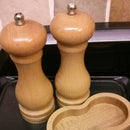Introduction: Wooden Laser Cut Jenga Pistol
Now, what could be more fun than Jenga? Jenga with guns!
This laser cut Jenga pistol contains a rubber band powered captive bolt which allows you to knock the blocks from the tower at never before seen speed and allowing you to perform feats that'll amaze your friends. Originally seen at Woodgears, this version's designed to be cut on a laser cutter and is an upgrade on the acrylic version that I previously made. It's easier to put together and requires fewer nuts and bolts.
Want one? Get a kit from the Instructables store.
Step 1: Design
The jenga pistol was designed in a trial version of Alibre Design, my favoured CAD package.
I went through several iterations to get to this stage with various attempts at getting the plunger, trigger and plunger guides correct. While designing it I wanted to keep it as simple to build as possible, with minimal screws and bolts holding it together. The trigger was designed so that it was its own spring, I didn't want to have to use a spring or a rubber band like in the acrylic jenga pistol that I made last year. The joints holding the pistol together are all interference fit, designed to either fit together tightly with no modification or after a very light sanding.
A laser cutter would be the tool of choice for this project, but it could easily be made with a paper template glued to 1/4" ply and then cut out with a scroll saw or a coping saw.
The files for either method are attached in this step. I've included:
1) The DXF files for laser cutting or for printing 1:1 scale to glue to wood
2) An EPS file, converted from the DXF files. Some laser cutters prefer this.
3) A PDF of the Alibre model. You can open this, click it and then use the controls to rotate it and look around the model.
4) A zipped copy of all of the Alibre files for opening, viewing and modifying.
Step 2: Tools & Materials
- 1/4" ply (12" x 24" should suffice)
- 1/8" acrylic (3" x 6" max)
- 2 off rubber bands
- 1 off 1 1/4" machine screw 1/8" diameter or less with matching nut and two washers.
- Small sheet of 80 grit sand paper
- Wood glue (optional)
- laser cutter
- printer
- scroll saw or coping saw
- drill
- a tiny bit more skill and patience
Step 3: Parts
This step contains an annotated photo with the names of the parts to make assembly easier. These names and are used throughout the assembly instructions so you can refer back here for clarification.
Step 4: Assembly: Clean
First, check you've received, cut or made all of the correct parts.
Lightly sand the non laser cut faces to remove small amounts of burn. Covering the ply with masking paper before cutting will reduce/eliminate this flareout. Do not sand any laser cut edges, some of them are required for precision interference fits.
Peel the protective layer from the four acrylic trigger pieces.
Step 5: Assembly: 1
Pick one of the large outer layers. Place it with the face with butt detail facing down.
Insert the two pegs into the rectangular holes in the stock of the pistol. A light tap with a small hammer may help them locate easily.
Step 6: Assembly: 2
Push the two stock spacers over the pegs and tap them down flush.
Step 7: Assembly: 3
Pass a washer over the machine screw. Thread it through the trigger pivot hole from the outside and lay the pistol back down.
Stack all four layers of trigger parts on top of each other and drop them over the machine screw.
Step 8: Assembly: 4
Place the second outer piece on top and tap it into place.
Drop the second washer onto the machine screw and then add the nut. Tighten by hand.
Step 9: Assembly: 5
Position two of the parts labelled "Assembly Aid" on top of one another to create a piece of ply 0.5" thick. Place these loosely into the gap between the two outer layers as shown in picture 1. Insert the final assembly aid through the slot. These are provided in the files to make assembly easier, they're not strictly necessary but help prevent strong hands crushing the parts during assembly if the joints are too tight.
Sand both shoulders at one end of the braces very lightly by placing the sand paper on a flat corner of a table and gently stroking the part along it.
Firmly press the three braces into place. You shouldn't need to tap with a hammer. If you've sanded too much, some wood glue and clamps can be used to hold it together.
Step 10: Assembly: 6
Knot a pair of rubber bands.
Put one side into the slot provided in the plunger.
Push one of the plunger guides into the slot.
Remove the assembly aids and insert the plunger through the slot.
Pass the rubber band around the front, through the band slots and back to the plunger on the other side.
Attach the second plunger guide.
Step 11: Play!
For most fun, play with a pair of pistols, or

Participated in the
Make It Real Challenge

Participated in the
ShopBot Challenge














